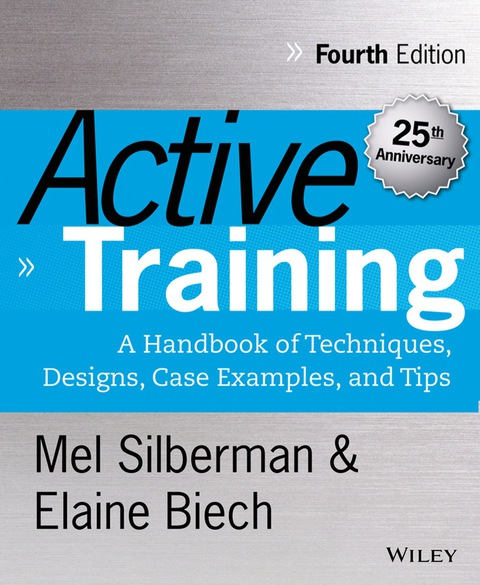Description
Efnisyfirlit
- Title Page
- Copyright
- Contents
- Acknowledgments
- Preface
- The Goals of This Book
- How This Book Is Organized
- Part One Introducing Active Training
- The Nature of Adult Learning
- The Social Side of Learning
- Concerns About Active Training
- The Delivery of Active Training
- Part Two Designing an Active Training Program
- Steps for Designing Active Training
- What’s in the Part Two Chapters?
- Chapter One Assessing Training Needs
- Why Do Assessment?
- What Information Should Be Collected?
- How Can Information Be Collected?
- Part I
- Part II
- What If There Is No Time to Do a Proper Assessment?
- Chapter Two Developing Active Training Objectives
- Setting Learning Goals
- Selecting Objectives
- Specifying Objectives
- Expressing Objectives
- Communicating Training Objectives to Others
- Developing Active Training Objectives
- Chapter Three Creating Opening Exercises
- What Opening Exercises Accomplish
- What to Keep in Mind When Creating Opening Exercises
- Ten Ways to Open an Active Online Virtual Training Session
- Ten Ways to Obtain Participation
- Chapter Four Preparing Brain-Friendly Presentations
- Five Ways to Gain Your Audience’s Interest
- Five Ways to Maximize Understanding and Retention
- Five Ways to Involve Participants During a Presentation
- Five Ways to Reinforce Presentations
- An Example of a Well-Designed Presentation
- Preparing Brain-Friendly Presentations
- Chapter Five Finding Alternative Methods to Presenting
- Demonstration
- Case Study
- Guided Teaching
- Group Inquiry
- Information Search
- Study Group
- Jigsaw Learning
- Learning Tournament
- Applying the Alternatives to a Common Topic
- Finding Alternative Methods to Presenting
- Chapter Six Using Experiential Learning Approaches
- Role Playing
- Games and Simulations
- Observation
- Mental Imagery
- Writing Tasks
- Instructions:
- Technical
- Performance
- Your Preplanned Questions
- Technical
- Performance
- Action Learning
- Background
- Current Status
- Planning Chart
- Using Experiential Learning Approaches
- Strategy Outline:
- Chapter Seven Designing Active Training Activities
- The Three Major Ingredients of Any Design
- Old Contract
- New Contract
- Basic Questions About Any Design
- The Remaining Details
- Three Tips for Creative Designs
- Designing a Training Activity
- Chapter Eight Sequencing Active Training Activities
- Basic Sequencing Guidelines
- Applying Sequencing Guidelines
- The Finer Side of Sequencing
- Experiential Learning Sequences
- Procedure
- Sequencing Active Training Activities
- Chapter Nine Planning Active Training Programs
- The Macrodesign of an Active Training Program
- Planning an Active Training Program
- Chapter Ten Incorporating Active Learning in All Training
- Asynchronous E-Learning
- Group-Based E-Learning
- Virtual Classrooms
- Blended Learning
- Social Media Expands Active Training and Development
- M-Learning Offers Instant Options
- Blending in Technology
- Part Three Conducting an Active Training Program
- Chapter Eleven Beginning an Active Training Program
- Preparing Yourself Mentally
- Arranging the Physical Environment
- Greeting Participants and Establishing Rapport
- Getting the Best from the First Thirty Minutes of Training
- Reviewing the Agenda
- Inviting Feedback to the Agenda
- Beginning an Active Training Program
- Chapter Twelve Gaining Leadership of the Group
- Setting Group Norms
- Controlling Timing and Pacing
- Increasing Receptivity to Your Leadership
- Handling Problem Situations
- Gaining Leadership of the Training Group
- Chapter Thirteen Giving Presentations and Leading Discussions
- Knowing Your Group
- Organizing Your Presentation
- Watching Your Body Language
- Adding Visuals
- Making Smooth Transitions
- Facilitating a Lively Discussion
- Giving Presentations and Leading Discussions
- Chapter Fourteen Facilitating Structured Activities and Promoting Team~Learning
- Structured Activities
- Team Learning
- Facilitating Structured Activities
- Promoting team Learning
- Chapter Fifteen Concluding an Active Training Program
- Reviewing Program Content
- Obtaining Final Questions and Concerns
- Promoting Self-Assessment
- Focusing on Back-on-the-Job Application
- Expressing Final Sentiments
- Concluding an Active Training Program
- Part Four Extending the Value of An Active Training Program
- Chapter Sixteen Providing for Back-on-the-Job Application
- Prior to the Training Program
- During the Training Program
- At the End of the Training Program
- Obstacle Assessment
- Peer Consultation
- Self-Monitoring
- To understand people better:
- To express myself more clearly:
- To assert my needs better:
- To exchange feedback better:
- To become more influential:
- To resolve conflicts more effectively:
- To become a better collaborator:
- Directions for Use
- Subject
- Follow-Up Coaching and Support
- Providing For Back-On-The-Job Application
- Chapter Seventeen Evaluating an Active Training Program
- Expanding the Four Evaluation Levels
- Designing Evaluations
- Obtain Feedback Along the Way
- Evaluating an Active Training Program
- Questions to Ask Your Sponsor about Results:
- Interim Feedback
- Part Five The Evolving Role of Trainers
- Chapter Eighteen Expanded Roles for Trainers
- Onboarding
- Leading Change
- Coaching Managers
- Mentoring Programs
- Internal Consulting
- Building Teams
- New Roles Action Plan
- Chapter Nineteen New Business Realities for Trainers
- Doing More with Less
- Globalization
- Working with Multigenerational Workforces
- Working with the C-Suite
- C-Suite Communication Checklist
- Vendor Management
- Working with Subject Matter Experts
- We’ve Reached the End-Or Is It the Beginning?
- Doing More with Less
- Globalization
- Working with Multigenerational Workforces
- Working with the C-Suite
- Vendor Management
- Working with Subject Matter Experts
- References
- About the Authors
- Index
- EULA






Reviews
There are no reviews yet.